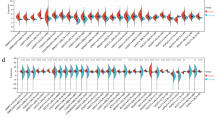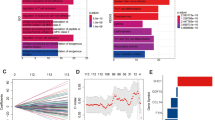Abstract
In oropharyngeal squamous cell carcinoma (OPSCC), the relationships between immune responses, carcinogens, and prognoses are not clarified yet. Here, we retrospectively reviewed the pathology samples of 46 OPSCC patients, and used p16 to determine their human papillomavirus (HPV) status. The Cancer Genome Atlas (TCGA) database was also analyzed for further comparison. The immunofluorescence staining of proinflammatory cytokines showed that high interferon gamma (IFNγ; T helper 1; Th1), low interleukin 4 (IL4; T helper 2; Th2), low thymic stromal lymphopoietin (TSLP; Th2), and low transforming growth factor beta (TGFβ; T regulatory; Treg) expressions were good prognostic factors for OPSCC. p16-positive OPSCC showed higher Th1, lower Th2/Treg proinflammatory cytokine expressions, and a better prognosis than p16-negative OPSCC. In smokers alone, although p16-positive OPSCC smokers showed weaker Th2/Treg predominant cytokine expressions than p16-negative OPSCC smokers, the prognoses of both groups were equally poor. As for p16-positive OPSCC patients alone, p16-positive nonsmokers showed a significantly better prognosis than p16-positive smokers, but the immune responses of both groups were all weakly Th2/Treg predominant. Overall, higher Th1 and lower Th2/Treg proinflammatory cytokine expressions are associated with a better prognosis for OPSCC. HPV may be related to increased Th1, decreased Th2/Treg responses, and a good prognosis, while smoking may be related to increased Th2/Treg, decreased Th1 responses, and a poor prognosis in OPSCC. The impact of smoking on immune deviation may be weaker than that of HPV, but the impact of smoking on prognosis may be stronger than that of HPV in OPSCC.



Similar content being viewed by others
Abbreviations
- CCL22:
-
C-C motif chemokine ligand 22
- CXCL10:
-
C-X-C motif chemokine ligand 10
- R:
-
Correlation coefficient
- DAB:
-
Diaminobenzidine tetrachloride
- FFPE:
-
Formalin-fixed, paraffin-embedded
- HNC:
-
Head and neck cancer
- HR:
-
Hazard ratio
- IF:
-
Immunofluorescence
- OPSCC:
-
Oropharyngeal squamous cell carcinoma
- PBST:
-
Phosphate-buffered saline with Tween 20
- ROC:
-
Receiver-operating characteristic
- TCGA:
-
The Cancer Genome Atlas
- TSLP:
-
Thymic stromal lymphopoietin
References
Liu C, Mann D, Sinha UK, Kokot NC (2018) The molecular mechanisms of increased radiosensitivity of HPV-positive oropharyngeal squamous cell carcinoma (OPSCC): an extensive review. J Otolaryngol Head Neck Surg 47:59. https://doi.org/10.1186/s40463-018-0302-y
Gillison ML, Chaturvedi AK, Anderson WF, Fakhry C (2015) Epidemiology of human papillomavirus-positive head and neck squamous cell carcinoma. J Clin Oncol 33:3235–3242. https://doi.org/10.1200/JCO.2015.61.6995
Hwang TZ, Hsiao JR, Tsai CR, Chang JS (2015) Incidence trends of human papillomavirus-related head and neck cancer in Taiwan, 1995–2009. Int J Cancer 137:395–408. https://doi.org/10.1002/ijc.29330
Lu DJ, Luu M, Mita A et al (2018) Human papillomavirus-associated oropharyngeal cancer among patients aged 70 and older: Dramatically increased prevalence and clinical implications. Eur J Cancer 103:195–204. https://doi.org/10.1016/j.ejca.2018.08.015
Anantharaman D, Muller DC, Lagiou P et al (2016) Combined effects of smoking and HPV16 in oropharyngeal cancer. Int J Epidemiol 45:752–761. https://doi.org/10.1093/ije/dyw069
Elrefaey S, Massaro MA, Chiocca S, Chiesa F, Ansarin M (2014) HPV in oropharyngeal cancer: the basics to know in clinical practice. Acta Otorhinolaryngol Ital 34:299–309
Welters MJP, Ma W, Santegoets SJAM et al (2018) Intratumoral HPV16-specific T cells constitute a type I-oriented tumor microenvironment to improve survival in HPV16-driven oropharyngeal cancer. Clin Cancer Res 24:634–647. https://doi.org/10.1158/1078-0432.CCR-17-2140
Lydiatt WM, Patel SG, O’Sullivan B, Brandwein MS, Ridge JA, Migliacci JC, Loomis AM, Shah JP (2017) Head and Neck cancers-major changes in the American Joint Committee on cancer eighth edition cancer staging manual. CA Cancer J Clin 67: 122–137. https://doi.org/10.3322/caac.21389
Litwin TR, Clarke MA, Dean M, Wentzensen N (2017) Somatic host cell alterations in HPV carcinogenesis. Viruses 9:206. https://doi.org/10.3390/v9080206
Shelton J, Purgina BM, Cipriani NA, Dupont WD, Plummer D, Lewis JS Jr (2017) p16 immunohistochemistry in oropharyngeal squamous cell carcinoma: a comparison of antibody clones using patient outcomes and high-risk human papillomavirus RNA status. Mod Pathol 30:1194–1203. https://doi.org/10.1038/modpathol.2017.31
Eckert AW, Wickenhauser C, Salins PC, Kappler M, Bukur J, Seliger B (2016) Clinical relevance of the tumor microenvironment and immune escape of oral squamous cell carcinoma. J Transl Med 14:85. https://doi.org/10.1186/s12967-016-0828-6
Kostareli E, Holzinger D, Hess J (2012) New Concepts for Translational Head and Neck Oncology: Lessons from HPV-Related Oropharyngeal Squamous Cell Carcinomas. Front Oncol 2:36. https://doi.org/10.3389/fonc.2012.00036
Hong CC, Yao S, McCann SE et al (2013) Pretreatment levels of circulating Th1 and Th2 cytokines, and their ratios, are associated with ER-negative and triple negative breast cancers. Breast Cancer Res Treat 139:477–488. https:doi.org/1007/s10549-013-2549-3
Watanabe J, Saito H, Miyatani K, Ikeguchi M, Umekita Y (2015) TSLP expression and high serum TSLP level indicate a poor prognosis in gastric cancer patients. Yonago Acta Med 58:137–143
Lee J, Taneja V, Vassallo R (2012) Cigarette smoking and inflammation: cellular and molecular mechanisms. Dent Res 91:142–149. https://doi.org/10.1177/0022034511421200
Heusinkveld M, Goedemans R, Briet RJ et al (2012) Systemic and local human papillomavirus 16-specific T-cell immunity in patients with head and neck cancer. Int J Cancer 131:74–85. https://doi.org/10.1002/ijc.26497
Peghini BC, Abdalla DR, Barcelos AC, Teodoro Ld, Murta EF, Michelin MA (2012) Local cytokine profiles of patients with cervical intraepithelial and invasive neoplasia. Hum Immunol 73:920–926. https://doi.org/10.1016/j.humimm.2012.06.003
Zhang D, Tang WJ, Tang D, Zhou J, Chou L, Tao L, Lu LM (2016) The ratio of CD4/CD8 T-cells in human papillomavirus-positive laryngeal squamous cell carcinoma accounts for improved outcome. Acta Otolaryngol 136:826–833. https://doi.org/10.3109/00016489.2016.1164341
Partlová S, Bouček J, Kloudová K et al (2015) Distinct patterns of intratumoral immune cell infiltrates in patients with HPV-associated compared to non-virally induced head and neck squamous cell carcinoma. Oncoimmunology 4:e965570
Edge S, Byrd DR, Compton CC, Fritz AG, Greene F, Trotti A (eds) (2010) AJCC cancer staging handbook: from the AJCC cancer staging manual. Springer, New York
Isayeva T, Xu J, Ragin C et al (2015) The protective effect of p16(INK4a) in oral cavity carcinomas: p16(Ink4A) dampens tumor invasion-integrated analysis of expression and kinomics pathways. Mod Pathol 28:631–653. https://doi.org/10.1038/modpathol.2014.149
Ang KK, Harris J, Wheeler R et al (2010) Human papillomavirus and survival of patients with oropharyngeal cancer. N Engl J Med 363:24–35. https://doi.org/10.1056/NEJMoa0912217
Mandal R, Şenbabaoğlu Y, Desrichard A et al (2016) The head and neck cancer immune landscape and its immunotherapeutic implications. JCI Insight 1:e89829. https://doi.org/10.1172/jci.insight.89829
Kano A (2015) Tumor cell secretion of soluble factor(s) for specific immunosuppression. Sci Rep 5:8913. https://doi.org/10.1038/srep08913
Esquivel-Velázquez M, Ostoa-Saloma P, Palacios-Arreola MI, Nava-Castro KE, Castro JI, Morales-Montor J (2015) The role of cytokines in breast cancer development and progression. J Interferon Cytokine Res 35:1–16. https://doi.org/10.1089/jir.2014.0026
Sokol CL, Barton GM, Farr AG, Medzhitov R et al (2008) A mechanism for the initiation of allergen-induced T helper type 2 responses. Nat Immunol 9:310–318. https://doi.org/10.1038/ni1558
Todaro M, Alea MP, Di Stefano AB et al (2007) Colon cancer stem cells dictate tumor growth and resist cell death by production of interleukin-4. Cell Stem Cell 1:389–402. https://doi.org/10.1016/j.stem.2007.08.001
Mann EA, Spiro JD, Chen LL, Kreutzer DL (1992) Cytokine expression by head and neck squamous cell carcinomas. Am J Surg 164:567–573
Woods KV, El-Naggar A, Clayman GL, Grimm EA (1998) Variable expression of cytokines in human head and neck squamous cell carcinoma cell lines and consistent expression in surgical specimens. Cancer Res 58:3132–3141
Uhlen M, Zhang C, Lee S et al (2017) A pathology atlas of the human cancer transcriptome. Science 357:eaan2507. https://doi.org/10.1126/science.aan2507
Pries R, Wollenberg B (2006) Cytokines in head and neck cancer. Cytokine Growth Factor Rev 17:141–146. https://doi.org/10.1016/j.cytogfr.2006.02.001
Al-Swiahb JN, Huang CC, Fang FM, Chuang HC, Huang HY, Luo SD, Chen CH, Chen CM, Chien CY (2010) Prognostic impact of p16, p53, epidermal growth factor receptor, and human papillomavirus in oropharyngeal cancer in a betel nut-chewing area. Arch Otolaryngol Head Neck Surg 136:502–508. https://doi.org/10.1001/archoto.2010.47
Mirghani H, Leroy C, Chekourry Y et al (2018) Smoking impact on HPV driven head and neck cancer's oncological outcomes? Oral Oncol 82:131–137. https://doi.org/10.1016/j.oraloncology.2018.05.007
Acknowledgements
The authors thank Chao-jung Chang, Chien-Hua Wu, Hong-Jing Chuang, Yi-Chuan Lee, Chiao-Lun Lan, Yao-Te Chung, and Ying-Yin Chen for their technical assistance, thank Fang-Yu Tsai and Shih Sheng Jiang in Taiwan Bioinformatics Institute Core Facility (National Core Facility Program for Biotechnology, 107–2319-B400-001) for TCGA database analysis, and thank the First Common Laboratory of National Taiwan University Hospital, Yun-Lin Branch for providing the experimental platform.
Funding
This study was financially supported by a project from National Taiwan University Hospital, Yun-Lin Branch (Grant Number NTUHYL107.C036).
Author information
Authors and Affiliations
Contributions
Conceived and designed the research: C-ML and Y-LY. Collected the data: C-ML and L-WL. Reviewed the pathologic slide: L-WL. Analyzed the data: C-ML, Y-WC and Y-LY. Wrote and edited the paper: C-ML, Y-WC and Y-LY. Whole correspondence: Y-LY.
Corresponding author
Ethics declarations
Conflict of interest
The authors declare that they have no conflict of interest.
Ethical approval and ethical standards
The Research Ethics Committee of the National Taiwan University hospital approved this study (NTUH IRB- 201711065RINC). All methods were performed in accordance with the Declaration of Helsinki.
Informed consent
Written informed consent was waived by the ethics committee which approved this study.
Additional information
Publisher's Note
Springer Nature remains neutral with regard to jurisdictional claims in published maps and institutional affiliations.
Electronic supplementary material
Below is the link to the electronic supplementary material.
Rights and permissions
About this article
Cite this article
Lin, CM., Lin, LW., Chen, YW. et al. The expression and prognostic impact of proinflammatory cytokines and their associations with carcinogens in oropharyngeal squamous cell carcinoma. Cancer Immunol Immunother 69, 549–558 (2020). https://doi.org/10.1007/s00262-020-02488-w
Received:
Accepted:
Published:
Issue Date:
DOI: https://doi.org/10.1007/s00262-020-02488-w




